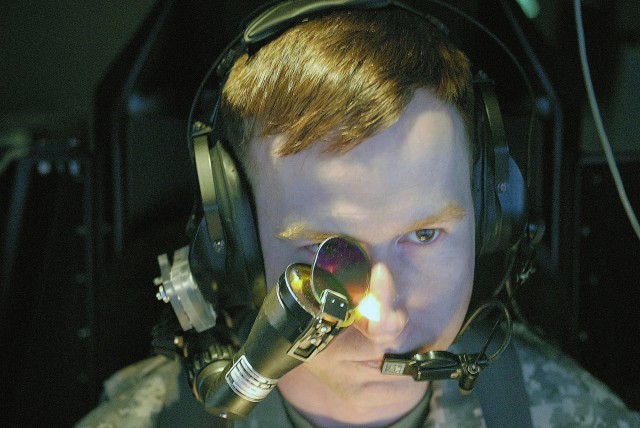CAMP TAJI, Iraq (Feb. 20, 2008) -- "It's a challenge to see if you a can engage all of the targets before they get you, and make it back to the airfield before you run out of gas," said Chief Warrant Officer 3 Robert Ladd, production control officer and maintenance examiner for the 4th Squadron, 3rd Armored Cavalry Regiment.
Fortunately Ladd wasn't facing that situation for real. He was describing one of the possible scenarios in what many aviators call the world's most expensive video game -- the Longbow Crew Trainer.
The LCT, a multi-million-dollar flight simulator, gives AH-64D Apache Longbow attack helicopter pilots an opportunity to sharpen their mission tasks and flight procedures in a safe environment.
"(The LCT) is classified as a full-motion trainer, which means when you sit in the seat it's going to feel and react like the real aircraft does," said Brad Carter, an LCT program manager and retired master aviator. "It gives the aviators a chance to practice emergency procedures that may not be safe to practice in the real aircraft or in this environment, (such as) 'shut down and restart an engine in flight' or 'lock up flight controls.'"
In flight school pilots start out in a trainer similar to this one to familiarize them with the aircraft before they get in the real thing, said Ladd.
"I've probably used the (LCT) more than 100 times, and as far as simulators go, it's probably one of the most reliable and realistic ones I've used (since) I've been an aviator," he said. "It allows us to get in some good training without having to go up and do it in the aircraft, which could lead to problems."
In the simulator, a programmer controls what scenarios the flight crew may experience during their training and monitors the crew's actions and communications during the simulated scenarios, said Dan Smee, an LCT programmer and retired Apache pilot.
"This screen displays the actual environment (hazards, such as) the sand and buildings. It's the threat," said Smee. "I can turn those threats on and off, I can make a new threat, or I can let the flight crews develop a scenario and add to or take away from the scenario to make it seem more realistic."
Communication between crewmembers is improved by the simulator because they are positioned on opposite sides of the room instead of being two feet away from each other (as they are in an actual cockpit), said Smee.
"This Longbow simulator also provides us an opportunity to train on gunnery engagements and tasks without actually having to go out and pull the trigger on real ammunition," said Ladd. "We have full range of our different types of (weapons), from Hellfire missiles to 30mm rockets, to fire in the simulator."
The crew can engage enemy forces generated by the simulator, which can vary from an individual person with a weapon to an entire army with tanks and helicopters.
There are 23 of the mobile simulators located around the world that can be loaded up and flown or driven to any location that has Apache pilots, said Carter.
Even though scenarios, like fighting through enemy forces to the airfield, are his favorite part of the simulator, Ladd says, the LCT definitely feels more realistic than a video game -- and it provides beneficial training.
"Everybody benefits from this simulator, because the more proficient the (pilots are), the better they are at their job; which means they're able to (successfully) support troops on the ground," said Carter.
"Sometimes I get the urge to go out there and fly the real thing, but I choose to come in here instead."
The simulator is designed to resemble an Apache cockpit, and uses parts from the actual aircraft, so steps must be taken to keep that equipment working properly.
"Like every other piece of Army equipment, we have our normal preventive maintenance (checks and services) we do on a daily basis," said Carter. "We have a pre-operational flight test that the inspectors do to make sure everything works properly, and when the flight crews are done we have a post-flight inspection. (It's) just like the real aircraft."
The LCT here is primarily in use by members of Task Force XII, the aviation task force that supports Multi-National Division - Baghdad. TF XII is led by the 12th Combat Aviation Brigade, a U.S. Army Europe unit based in Ansbach, Germany.


Social Sharing